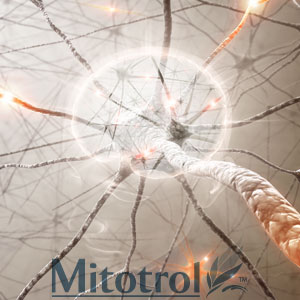Mitotrol
Unlocking a Major Cause of Disease
Mitochondrial medicine, new on the medical scene, is a rapidly developing science.


Even though mitochondrial disease research dates back to the 1940s, the first diagnosis of a mitochondrial disorder dates back to 1959. In 1963, researchers uncovered a different type of DNA in mitochondria creating its own blueprint (mtDNA) that differed from nuclear DNA (nDNA) found in the nucleus of cells.
Today, mitochondrial research involves a multitude of medical specialists, including:
- Doctors specializing in metabolic diseases
- Cell biologists
- Molecular geneticists
- Neurologists
- Biochemists
- Pathologists
- Immunologists
- Chiropractors
- Embryologists
Mitochondrial and metabolic medical conditions, including more than 40 different identified diseases with varying genetic features, are called mitochondrial cytopathies. Each shares the common factor of having the inability to completely burn food and oxygen to generate energy.
Within each cell, mitochondria are tiny energy “factories” converting chemical fuel into energy. More and more research indicates that mitochondria play a vital role in aging and age-related ailments, such as type 2 diabetes, Parkinson’s, Alzheimer's and heart disease. In older adults, mitochondria function less efficiently than in younger people. This is a change that may be related to insulin resistance, a trigger for diabetes.
Are mitochondria responsible for a cell’s survival?

Research found that genetically-engineered cells with higher levels of a mitochondrial enzyme (NAMPT) were better protected and more resistant to dying when subjected to toxic chemicals. Research also found that as long as the cells' mitochondria were healthy, they could maintain themselves regardless of their condition.
What are the symptoms of mitochondrial diseases?

Mitochondrial diseases are categorized according to the symptoms they present to various organs, including:
- Brain
- Nerves (including nerves to stomach and intestines)
- Muscles
- Kidneys
- Heart
- Liver
- Eyes
- Ears
- Pancreas
In some patients, a single organ may be affected; in others, all organs may be involved. Mitochondrial illnesses can also range in severity from mild to fatal.
Depending on which cells of the body are affected, symptoms might include:
- Dementia (mental disorder characterized by confusion, disorientation, and memory loss)
- Developmental delays, learning disabilities
- Diabetes
- Gastrointestinal disorders, Including severe constipation
- Growth impeded
- Heart, liver, or kidney disease
- Increased risk of infection
- Mental retardation
- Muscle coordination loss and muscle weakness
- Neurological problems, seizures
- Respiratory disorders
- Thyroid dysfunction
- Visual impairment and/or hearing losses
Mitotrol nutritionally supports the mitochondria’s ability to create cellular energy


Mitotrol contains compounds (alpha glucans) classified as a non-dialyzable high molecular weight with low molecular weight polypeptides.
The molecular weights of the different compounds range from 150 to 300 kDa. A major chemical feature of Mitotrol is the presence of D-glucose units in the main chain. Side-chain D-glucose units are linked via a 1, 6 to the main chain with low molecular weight polypeptides representing 9.5 percent of the substance at non-reducing terminal.
These plant-based glucans give many plants their important medicinal properties. Alpha-glucans are much smaller in molecular size than the well-known beta glucans, and therefore, easily absorbed by the body.
The alpha glucans in Mitotrol come from combining specific families of whole grain rice taken through a proprietary process that provides a higher ratio of alpha to beta glucans. Whole grain rice in general contains much higher levels of alpha forms of glucans than beta. Since rice is safe for all blood types, Mitotrol is fast becoming the product of choice over many mushroom-based products where the ratio of alpha to beta glucans is reversed.
A recent independent study conducted by The Royal Thai Army Hospital and College of Medicine in conjunction with PMK Research Center, Bangkok, Thailand, and Emory University School of Medicine, Atlanta concluded: “The same whole grain rice polysaccharides and polypeptides in Mitotrol were shown to increase cellular energy (ATP) up to 54 percent. “
Results of these in vitro studies demonstrated that when neurotoxins were induced, they killed all the cells and severely damages the dendrites (fibers extending from the body of the cell). However, when neurons were pre-treated with rice polysaccharide peptides, they showed different levels of cell survival and apparent recovery of dendrites from the neurotoxin injuries within 48 hours. This study suggested that there may be a place for rice polysaccharide peptides in the nutritional support of brain-related injuries and diseases.
Other useful studies on Alpha-glucans
Anti-diabetic effects of Alpha-glucans
J Pharm Pharmacol. 2007 Apr;59(4):575-82. Anti-diabetic effect of an alpha-glucan from fruit body of maitake (Grifola frondosa) on KK-Ay mice. Hong L, Xun M, Wutong W. School of Life Science and Technology, China Pharmaceutical University, Nanjing 210009, China. PMID: 17430642 [PubMed - indexed for MEDLINE]
Reducing the inflammation in Colitis with Alpha-glucans
Br J Nutr. 2009 Sep 22:1-10. [Epub ahead of print] Lavi I, Levinson D, Peri I, Nimri L, Hadar Y, Schwartz B.
Institute of Biochemistry, Food Science and Nutrition, Faculty of Agricultural, Food and Environmental Quality Sciences, The Hebrew University of Jerusalem, Rehovot 76100, Israel.PMID: 19772681 [PubMed - as supplied by publisher]
Alpha and beta glucans increase cellular ATP levels
Cellular energy, which is also known scientifically as the ATP/IP ratio. Cordyceps has been clinically proven to increase cellular Bio-Energy by as much as 55% (Reported XU C.F et al in ZHU J-S, Halpern GM, Jones K. The Scientific rediscovery of a precious ancient Chinese herbal regimen: Cordyceps sinensis: Part I. J Alt Comp Med 1998;4(3):289-303.)